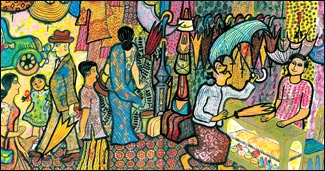Art of Sybil Wettasinghe
Anoli PERERA
Sybil Wettasinghe is more remembered as the author and illustrator of
Kuda Hora, a legendary Sri Lankan children's story which has been read
and cherished by many generations of kids. A pioneer in the field of
juvenile story writing and illustrating in Sri Lanka, Wettasinghe's
stories for children and her delightful rendering of images innovatively
brought into life the essence of the tales narrated.
Introducing her own particular style as a book illustration artist as
well as a prolific storyteller, her work set off a new genre of story
books for children that had a rootedness in a particular indigenous
idiom. It unselfconsciously unfolded the local village aspirations and
the simplicity of life that is romantically linked to it.
Secret mythology
 Referring
to the practice of writing, Roland Barthes has noted: ".... imagery,
delivery, vocabulary spring from the body and the past of the writer and
gradually become the very reflexes of his art. Referring
to the practice of writing, Roland Barthes has noted: ".... imagery,
delivery, vocabulary spring from the body and the past of the writer and
gradually become the very reflexes of his art.
Thus under the name of style a self sufficient language is evolved
which has its roots only in the depths of the author's personal and
secret mythology....".
Such speculations invite us to ponder on aspects of Wettasinghe's
life to grasp certain nuances and quintessence that is embedded in her
work. Wettasinghe grew up in the cozy village environment of Gintota, a
small town in the South near the port town of Galle, with its happy
childhood memories, and her work provided an extensive canvas for her to
recapture the nostalgic reminiscences of its blissful moments.
Nethra Samarawickrama in her biographical note on Wettasinghe writes:
"Her autobiography 'Child in Me' provides a richly detailed account of
the characters she came across, ranging from stilt walkers who visited
the village and recited nadagam melodies and tom-tom beaters who carried
the announcements of the temple to kavikolakarayas who conveyed news to
the village through their long drawn poetic recitations".
In the 1920s Gintota still had the feel of the rural, and largely
operated within a traditional value system and a way of life.
Stereotypical characters
Throughout her work Wettasinghe tries to capture this aspect of rural
life, the nature of interactions and relationships within the community
and their close proximity to nature.
When reading her work, we are literally and metaphysically nudged to
fall in love with her village, its stereotypical characters, their
idiosyncratic behaviour and the witty and colourful dialogs that project
a harmless, laidback world within which one feels so content to be in.

Juxtaposed against the historical Legacy of Euro - American juvenile
stories based on sources such as legendary Grimms' Fairy Tales, stories
of Hans Christian Andersen and others spun by many foreign authors that
were dominating the Sri Lankan child's imaginary world for a long time,
Wettasinghe's world of characters with its localized experiences and
episodes certainly provided the juvenile story writing in Sri Lanka a
decentring possibility from the European storytelling traditions and
their nuances.
If Eurocentric storytelling through stories such as 'Snow white,
Cinderella and the Sleeping Beauty' brought to life the narratives of
white princess, fire eating dragons, dark wicked stepmothers and
European castles stimulated an alien fantasy in the Sri Lankan context,
Wettasinghe's Kuda Hora, 'Vesak Lantern' and the Duvana Revula
familiarized the urban child with the most joyous possibilities of
village life playfully enriched with references to local customs,
elements of cultural imagery and the splendour of its natural
environment.
As much as Wettasinghe's work tantalized the child's imaginary world,
it also provided children's story book writing a new link to a folk
storytelling tradition rooted in the Sri Lankan context.
Urban life
While she was sympathetic and nostalgic toward the village that
inspired her to romanticize it, she as unhesitant in wittily critiquing
the urban life though her works such as Kusumalatha.
This particular orientation also posited the village as pure and
urban as contaminated with its familiarity with colonial and western
ways of life.
This became a popular genre for many creative works of literary
writers, filmmakers and artists during the 1950s and 1960s. The pre and
post independent anxieties of finding an 'authentic self within the
nation building project revived the interest in the traditional and the
indigenous during the decades following 1948.
Literary figures
In this socio-political environment Wettasinghe's work which, largely
privileged folk culture, found an ideologically compatriotic audiences
and endorsers from the Southern Sinhala art and literary figures such as
Martin Wickramasinghe, Chandraratne Manawasinghe, W. A. Silva and Sunil
Shantha.
A forerunner of illustration artists in Sri Lanka, Wettasinghe turned
women's creative energy into establishing an independent artistic
profession that did not have a legacy that as locally rooted.
Storytelling was mostly a woman's task within her domesticity of child
rearing where lullabies' and numerous stories were recounted to kids by
female members of the families.
While some of these were commonly narrated tales from folktales or
fairytale that were circulated in society, others are made up or
reinvented with variations to keep the attention of the young.
It is through these acts of storytelling that children first became
familiar with the social behaviour systems, customs, norms and basics of
morality. |



